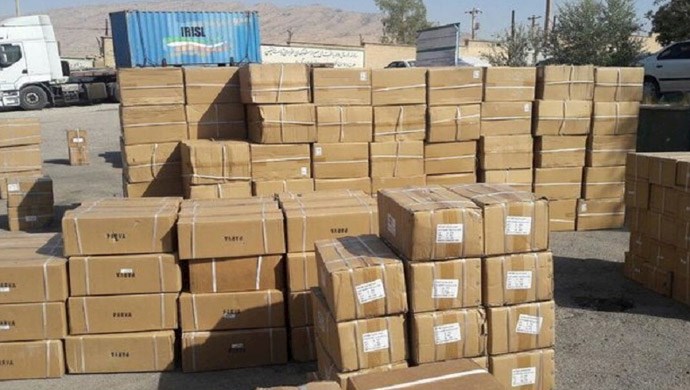Analysis by PMOI/MEK
Iran, May 15, 2021—In a meeting of the government's economic coordination headquarters, Iranian regime president Hassan Rouhani called the smuggling of goods "a disgraceful and harmful thing for a healthy and transparent economy and trade in the country," according to his website on May 11.
Despite Rouhani's remarks, smuggling of goods, like other economic corruption, is systematic in the regime, and according to various estimates by government entities, more than a third of imported goods are smuggled into the country.
In May 2020, a program by the state-run Shabakeye Yek referred to a research by the Majlis (parliament) and reported: "Smuggling of one-third of imported goods and the discovery of only one to eight percent of smuggled goods in the country was one of the important points of this report. But the most astonishing part of this report is that most of the smuggling is taking place through official ports and border crossings.”
The large scale of smuggling includes many domains such as clothing, food, and even bitcoin mining machines.
In this regard, the official IRNA news agency reported on May 17, 2020: "In its study, the [parliamentary] investigation board found 31 tricks and methods of smuggling goods, which, despite the statements of some officials, including the officials of the Customs Organization, more than 95 percent of these cases are carried out in the form of official procedures and official ports and border crossings. According to the report, the main methods of foreign currency smuggling have been identified. About 95 percent of smuggled goods enter the domestic market, the volume of smuggling can account for more than 35 percent of imports, and the discovery of cases are close to four percent."
IRNA further reported that the Majlis’s finding show that despite some assessments and statements, methods such as importing goods with kolbar (porters), imports with luggage, or smuggling by small motorboats do not have much effect on the circulation of smuggled goods in the country. Policymaking in this domain and facilitating imports for border residents can not have much impact on the national economy, IRNA continued.
But while the regime’s security forces regularly kill an injure fuel traders and porters across the country’s borders, they’re doing next to nothing to clamp down on the largescale smuggling of goods that happen every day.
This oppression of Kolbars and fuel traders comes at a time when thousands of smuggled trucks and ships enter the country daily from ports and official bases affiliated with the Revolutionary Guards.
"Smuggling, especially organized trafficking, is one of the barriers to production," said judiciary chief Ebrahim Raisi in a special meeting to evaluate the process of combating economic corruption in the country, according to a April 29 report by the Mizan news agency.
In the same meeting, the inspector of the judiciary’s branch for addressing goods smuggling acknowledged, "Goods smugglers are more organized today than ever before.”
IRNA quoted Abdolnasser Hemmati, the head of the Central Bank of Iran, as saying, “It is important to reform the distribution system. Of course, everyone must prevent the smuggling of goods into the country. Smuggling of goods really hurts production and livelihoods. Our distribution system is very flawed and needs to be reformed.”
During the 2017 presidential debates, Eshaq Jahangiri, Rouhani’s first vice president, said, "When we took over the government, it was estimated that there was $25 billion worth of smuggling.”
But three years later, Hassan Norouzi, Member of the Majlis Investigation Committee of the Anti-Trafficking in Goods, confirmed that nothing has changed. In an interview with the state TV in May 2020, Norouzi said, “We believe that up to $25 billion goods enter the country throughout smuggling from official ports and border crossings.”
In its report, the Parliamentary Research Commission has declared that 12 government institutions are performing weakly in regard to preventing smuggling. These institutions include the Chamber of Commerce, Customs Organization, Ministry of Economy, Secretariat of Free and Special Trade Zones, Chamber of Trade Unions, Ministry of Foreign Affairs, Organization for Collection and Sale of State-owned Properties of Iran (OCSSPI), Cooperative Chamber, Ministry of Interior, Radio and Television Organization, the State Security Forces, and the Ministry of Health.
This begs the question, how powerful must the smuggling network be that the main government institutions can’t do anything to stop them? And what is this powerful network that, according to Raisi, can have this amount of "organized and professional smuggling"?
This network is run by none other than the Revolutionary Guards, which former President Mahmoud Ahmadinejad and later Hassan Rouhani referred to as the "smuggling brothers."
Given the IRGC’s political and economic clout, it’s no wonder that the institutions mentioned in the parliamentary investigation report have no power to deal with the alarming level of organized smuggling.
The IRGC is in control of at least 114 ports and 25 airports, which it uses to smuggle goods.
The IRGC uses these ports to establish a very profitable network of illegal imports, at the expense of the country’s economy. With ever billion dollars of smuggled goods, more than 100,000 jobs are destroyed, let alone tens of billions. At the same time, many production facilities are facing bankruptcy and closure.
The Revolutionary Guards and other Khamenei-affiliated institutions are putting economic pressure on the people through massive smuggling of goods, especially when the people need support more than ever as they are struggling with Covid-19 outbreak.





